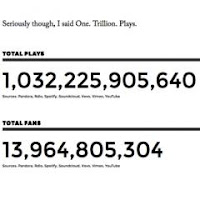It’s funny how all the players in the music business are faced with the same questions when it comes to streaming distribution. Are all streams being counted? How many actually generate revenue and how much is it? Is the revenue actually making it to the right places?
Artists, bands, musicians, songwriters, managers, labels and publishers ask these questions every day and the answers they receive are often vague, or worse, contradictory.
Take for instance the latest data from a survey conducted by Next Big Sound that counts the number of streams for the first 6 months of 2015. The company found that there were 1,032,225,905,640 (or 1.03 trillion) song plays on Pandora, Rdio, Spotify, SoundCloud, Vevo, Vimeo and YouTube during that period.
Now what’s interesting is that this is only a partial list of streaming services with significant subscriber bases. iTunes Radio, Deezer, Slacker, Rhapsody and Google Play, among others, weren’t included, so this total could actually be low.
Now here’s where the confusion comes in. Nielsen Music’s mid-year report states that there were only 135 billion on-demand streams during the first half of the year. This was based on data from AOL, Beats, Cricket, Google Play, Medianet, Rdio, Rhapsody, Slacker, Spotify, Xbox Music and YouTube/Vevo.
As you can see, only Rdio, Spotify and YouTube/Vevo were included in both surveys, but doesn’t that 135 billion figure still feel a little low? Some discrepancy is understandable due to the fact that Nielsen only included interactive services and not radio-like services like Pandora, but a difference of a factor of almost 10 screams out that something’s not quite right here.
Then there’s the question about getting paid, because after all, 1 trillion is a lot of streams.
It would be nice if there was a single rate that each and every stream was worth regardless of the streaming service that it came from, but unfortunately it’s not that simple.
For instance, interactive streams where the user can actively choose which song is streamed (like Spotify) pay a higher rate than non-interactive streams that are more radio-like (like Pandora). Plus the free tier of both pays less than the premium subscription tier. To make it a little crazier still, different countries may pay different rates, Spotify pays what amounts to a bonus for greater market share, YouTube pays less than them all, and some views might not pay anything. Read more on Forbes.


No comments:
Post a Comment